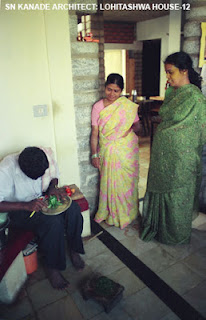Whose responsibility it is anyway?
"A child's feet are seen in the crib" (The feet show child's future) — How the child would lead life in future — a Marathi idiom. It indicates people's belief in fate. Isn't there any responsibility of the parents / guardians, teachers and society to help child's development? To say tradition is always best is merely a dogma.
Image-1
Image-1
 | ||
| ‘The Formative Age’ by Remigius de Souza, Mumbai, 2003 |
Image-2
 |
| Sapling in a Tree-pot |
In the tropics, light and moisture are enough for plants to live.
Even plants turn around in search of light for their growth. In crowded plants each finds its way; sometimes they grow straight up and higher, sometimes bend around, in the direction of light. There are no quarrels, fights, arguments! (If there are any, we do not understand their tongue.)
Image-3
 |
| Plant on a pavement in Mumbai - 1 |
This tree is on my usual walkway. During monsoon a beautiful creeper grew in the hollow of its trunk. One day found it vanished: Perhaps a dutiful street sweeper had removed it. At the same time new shoots grow from the trunk and roots.
Wherever there is natural thick tree cover, especially in the mountain ranges, there we get to see such a scene, also in a mass plantation. In cities, too, on the street pavements, the transplanted saplings (from nurseries) helped by watering, invariably grow in various directions.
Municipalities probably do not know the right "places and spaces" for the growth of various plants. Oh, those who don't know about the appropriate 'place and space' for the growth of humans, how could they have any concern for the plants?
Image-4
 |
| Plant on pavement in Mumbai - 2 |
Plants, too, wish to live despite various adversities, one of them is modern urban aesthetics (and ethics) about Life and Survival.
Image-5
 |
| Detail, Plant on pavement in Mumbai - 3 |
On pavements of Mumbai/ two generations of the displaced and
marginalized are born and grew up. Who knows where did they reach? How
could the impotent know?
There is an idiom, 'under a great tree other plants don't grow'. However, it is applicable to plantation by humans. Actually, it refers to great persons, or humans, certainly not great trees.
In a natural forest, a great tree supports many a animal and plant species.
Cut down a great tree and see what happens. It not only destroys Life of so many species, but also, affects environmental balance, reduces ground water, causes desert to expand, droughts and famines begin...
But what is it to the egocentric, greedy power-mongers? No regrets or shame! If poor ryot starve, it is not a spicy news story!
Mother Nature, 'Srishti', provides resources (and autonomous functions) for the sustenance and protection to all the species — their body and mind — in their schema, may they be bacteria or human species. Her management is not at all like that of selfish, power-greedy civilized societies. Not even their gods (of human species) can interfere in Mother Nature's affairs.
Nature, here, isn't romantic greenery in poetry / fiction. Just as Mother Nature occupies all the known-unknown universes, so also is within us.
She does, so do we, want us to grow in body and mind, which requires appropriate 'place and space'.
Here, 'place' is not area, i.e. sq ft/sq m area by government rule book. And 'space' is not 3D box/block in geometry.
Two extreme examples
First example is of the collective, and second is of an individual. These are two far ends of recent examples from civilized society.
1st. In Vietnam a generation was born on the war field, grew up with gun and fought war with the US. The US lost the war.
2nd: Maharaja Sayajirao Gaekwad III of former Baroda State. His relations with British Raj are well known. His comprehensive development work for People is more eye-catching than his worldly wealth.
Who was Sayajirao? A boy, from a humble family, adopted in the royal family to be a king!
What is the use of mere wealth of a rich person without right formation? Truly he was 'Rajarshi', Sage-King or Sage-Statesman.
Between the two ends in the above two examples, it may be worth to examine a million cases. But the advance societies/experts stop short at sample surveys. In their tongue there is no idiom, 'as many persons that many characters'.
Otherwise they often publish reports, about Internet, TV, cell phone users etc.
There is a third example, outside civilized society. Here it is mentioned only for record though most important. Most people are not familiar about them. They are the aborigines, 'adivasi', communities in India and the world. Their communities and culture have beginning in the remote ancient times.
________________
1.The poster was written while I was writing a number articles on education during past three decades.
2. This post is translated from the original post published on my Marathi blog: REMICHI MARATHI BOLI.
3. I have written few notes about the aborigines in India. Some are published in print and on this blog.
©Remigius de Souza, all rights reserved.





























